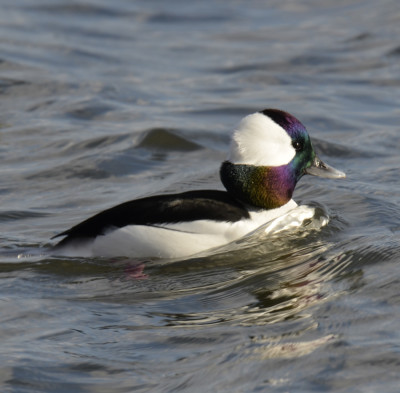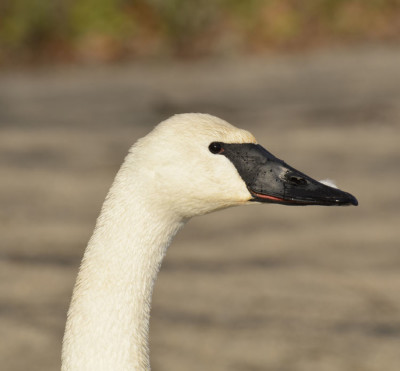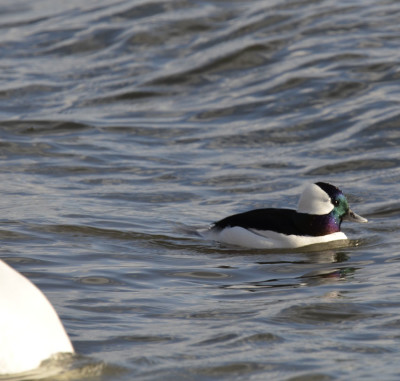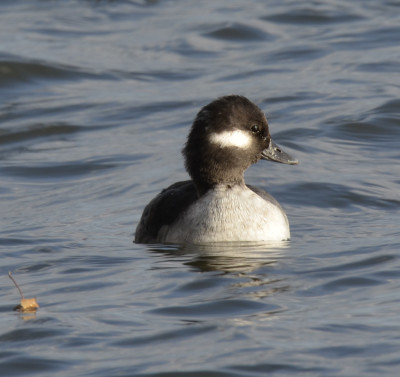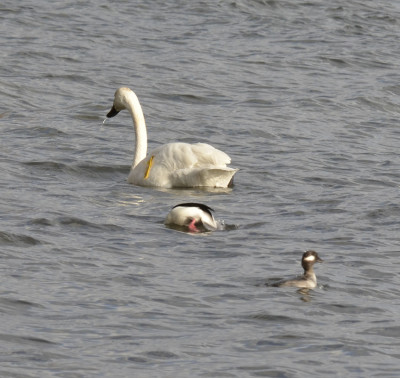Recently, I wandered all the way west to visit the LaSalle Park Marina in Burlington. It’s the park where many of the re-introduced Trumpeter Swans over-winter. It was a blustery day and the wind was tossing generous waves in towards shore. Several Trumpeter Swans were in the water, using their long necks to feed from the bottom, and around them, also feeding, were groups of Mallards and even Bufflehead; As I watched, I wondered why.
What Do Trumpeter Swans Eat?
I have seen Mute Swans surface with clumps of underwater plants which their young eagerly snap up, even fighting for the long slimy strands. I wasn’t sure if Trumpeter Swans are also after plants or not. A quick check of the AllAboutBirds website confirmed that adult Trumpeters are mostly vegetarians. So the swans I saw “tipping up” near the Marina were probably pulling up underwater weeds even though I did not see them lift and swallow any.
Why Are There Mallard Ducks Surrounding the Trumpeter Swan Feeding in the Water?
The only Mallards I saw feeding in the water were in small groups, each quite close to a Trumpeter Swan.
At first, I thought the ducks might be using the Swan as a warning system for predators. Then I realized the Swan was very seldom raising its head above the water. It was the Mallards, not the Swan, that kept sounding the alarm when a dog was walked past.
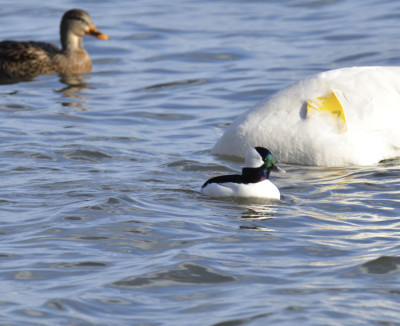
Mallards and Bufflehead near Trumpeter Swan
I began to wonder if the ducks were feeding near the Swans because the Swans had found an abundant food supply that the ducks were also interested in.
Mallards have a more eclectic diet than Swans. They will eat small fish, frogs, invertebrates, and other creatures as well as plants, seeds and grains. So it wasn’t easy to guess what the Mallards wanted.
That didn’t particularly explain why each time the Swan slowly left an area, feeding its way a few dozen yards down the Lake, the Mallards followed it. It’s possible they were all moving following a food source but if the Swans are rarely, if ever, interested in fish, it didn’t seem likely.
Then I noticed a male Bufflehead feeding almost under the Swan’s feet.
Bufflehead Also Enjoy a Feeding Trumpeter Swan’s Company
Bufflehead are diving ducks. This one was popping up and down steadily. The water was shallow enough for the Trumpeter Swan to reach bottom so it didn’t take the Bufflehead long to do the same. Or at least its dives were short and frequent.
The Cornell website says that Bufflehead dive to catch aquatic invertebrates. They enjoy things like dragonfly larvae, water boatmen, caddis fly larvae and some snails and clams in winter. They also eat some vegetation and seeds.
There were larger groups of Bufflehead resting a bit further out from shore in several places. This one male, however, stayed diligently diving very close to the Swan. After about 5 minutes, he surfaced and began to swim away.
Do Bufflehead Often Call or Quack?
I stayed where I was, though, so as not to alarm the large flock of resting Trumpeter Swans on the beach that I was standing amongst. As I stood, watching the activity of a flock of Scaup landing out in Hamilton Harbour, I noticed the male Bufflehead was returning. He was bringing back his mate!
Bufflehead, according again to AllAboutBirds, generally stay in pairs even during the winter.
The male and female then BOTH began diving very close to the Swan.
The first thing this reminded me was that these are very quiet ducks. The Mallards had been keeping up a steady dialogue amongst themselves, warning rival males away from females, alerting everyone to passing dogs, and just generally gabbling.
I had not heard any sound from this or any other Bufflehead, though. And when the male wanted to tell the Female “Hey, the diving’s good over here!” He had gone off in search of her and led her back.
Apparently, the males do call during courtship and the females do call to their young but neither is particularly noisy.
Back to Feeding the Bufflehead Continue to Dive
So why were the Bufflehead, and Mallards, feeding so close to the Swan? My best guess is that the Swan was stirring up a mess when plucking weeds from the bottom of the lake. Perhaps its steady feeding was exposing previously hidden invertebrates such as insect larvae to the hungry Bufflehead and Mallards. I can’t tell for sure, unfortunately.
I did notice another pair of Bufflehead feeding quite close to another Trumpeter Swan further down the shore.
The late, late, late fall afternoon sun started to fail as clouds rolled in so I carefully and slowly retreated from my watching post amongst the resting shore-bound swans. It had been a pleasant reflective interlude on a somewhat sunny day.
Related Reading
- Trumpeter, Tundra and Mute Swans Winter on Lake Ontario
- Spring Swans Feel Territorial Tension
- What Is This Crazy Black Duck with the White Bill?
- Bufflehead Pop Out of the Lake Like Corks Rising
Join In
Have you watched who feeds with the Swans? Have you noticed any patterns of behaviour? Please share your interpretation with a comment.

